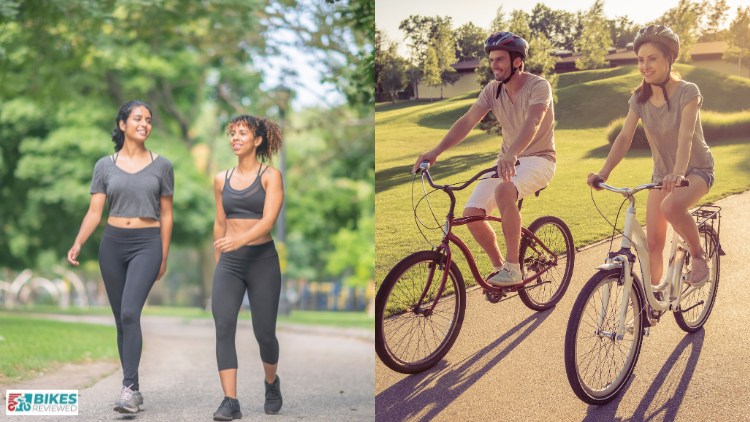When it comes to staying fit and healthy, regular physical activity is key. Two popular forms of exercise are walking or biking, both of which offer various benefits. One important aspect to consider is how many calories each activity burns. Let's explore the calorie-burning potential of walking and biking in simple terms.

How Many Calories Walking Burns?
Walking is a simple yet effective way to get moving. It doesn't require any special equipment, making it accessible to almost everyone. The number of calories burned during a walk depends on factors like speed, distance, and individual factors like weight and metabolism.
- Walking Speed: The faster you walk, the more calories you burn. A brisk walk engages more muscles and increases your heart rate, leading to higher calorie expenditure.
- Distance: The farther you walk, the more calories you burn. Going for longer walks means your body is working continuously, using up energy and helping you shed those extra calories.
- Inclines: Walking uphill or on an incline also boosts calorie burn. The effort required to move against gravity increases the intensity of the exercise.
Generally, a moderate-paced walk can burn around 240-300 calories per hour, while a brisk walk can increase that number to 350-400 calories per hour.
How Many Calories Biking Burns?
Biking, whether outdoors or on a stationary bike, is another excellent cardiovascular exercise. Like walking, the number of calories burned while biking depends on several factors.
- Speed and Intensity: Just like walking, the speed at which you bike affects calorie burn. Faster speeds and higher intensity levels result in more calories being expended.
- Terrain: Biking on different terrains can impact calorie burn. Riding on hilly terrain or rough paths requires more effort, leading to increased calorie expenditure.
- Duration: The longer you bike, the more calories you burn. Extended biking sessions contribute to a higher overall calorie burn.
On average, biking at a moderate pace can burn approximately 400-500 calories per hour. If you increase the intensity and speed, the calorie burn can go even higher, potentially reaching 600-700 calories per hour.
Which is Good at burning Calories Walking or Biking?
When it comes to the calorie-burning showdown between walking and biking, it's essential to consider personal preferences, health conditions, and fitness goals.
- Accessibility: Walking is more accessible to most people since it doesn't require any special equipment. You can simply step outside and start walking.
- Impact on Joints: Walking is a low-impact exercise, making it gentler on the joints. This can be crucial for individuals with joint issues or those looking for a sustainable long-term exercise routine.
- Variety: Biking offers variety, allowing you to explore different terrains and cover more distance in a shorter time. It can be an excellent choice for those who enjoy the outdoors and want a more dynamic workout.
- Calorie Burn: Both walking and biking can be effective for burning calories. If your primary goal is to maximize calorie expenditure, biking at a higher intensity tends to have a slight edge.
Ultimately, whether you choose walking or biking depends on your personal preferences, fitness level, and health considerations.
Both activities provide numerous health benefits and can be enjoyable ways to stay active.
To make the most of your exercise routine, consider incorporating a mix of walking and biking based on your goals and lifestyle.
Also Read - How Many Calories Do We Burn On An Exercise Bike
Health Benefits of Walking and Biking
- Cardiovascular Health: Both walking and biking are excellent cardiovascular exercises, promoting heart health by improving circulation and reducing the risk of heart diseases.
- Weight Management: Regular walking or biking can contribute to weight management by burning calories and improving metabolism. Combining these activities with a healthy diet can support weight loss or maintenance.
- Mental Well-being: Exercise is not only good for the body but also for the mind. Walking and biking release endorphins, the "feel-good" hormones, which can help alleviate stress, anxiety, and depression.
- Muscle Engagement: While walking primarily engages the muscles in the lower body, biking involves muscles in the legs, core, and even the upper body to some extent. This muscle engagement helps tone and strengthen various muscle groups.
- Joint Health: Walking is a low-impact exercise that is gentler on the joints, making it suitable for individuals with arthritis or joint pain. Biking, particularly on a smooth surface, is also generally easy on the joints.
In the end, the "walking or biking" debate is not about finding a winner; it's about finding what works best for you. Both activities offer a plethora of health benefits, and the ideal choice depends on your preferences, fitness level, and overall well-being.
Whether you choose to explore your neighborhood on foot or pedal through scenic routes on a bike, the most important thing is to stay active and make exercise a consistent part of your lifestyle. By finding joy in the activity you choose, you're more likely to stick with it, leading to a healthier and happier you.
